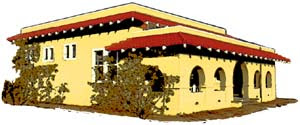Mojave River Valley Museum in Barstow, California.
Trevor Summons, CorrespondentSan Bernardino Sun
With so much concrete around us, it's sometimes hard to imagine that life was not always this way. Take away the roar of the freeway running close by and you can begin to piece together life as it used to be at the Mojave River Valley Museum.
It's perched up above the cut that now provides access to Interstate 15, with people heading out to Sin City several hours away to the east.
Back in 1776, Father Francisco Garces came along this way as the first European to forge tracks across the almost empty land. But he was not the first human.
Long before Europeans arrived, the Native Americans used the route as a trading link, leaving behind evidence of their lives in the form of baskets and jewelry, pots and other artifacts.
Explorer Jedediah Smith came through in 1826 and soon afterward the road became a busier, and more dangerous thoroughfare. It's hard to imagine today but you took your life in your hands if you traveled this way.
The museum is quite small but crammed with a huge variety of artifacts.
Wandering around the glass-fronted cabinets, I was taken with a couple of old uniforms. They belonged to Herbert J. Simmons. He served as a soldier in World War I, and then once again as a seaman out in the Pacific in World War II. It must have been tough for those people who were of an age where they were liable for service in both those mighty conflicts.
Next to this display I came upon a little bit of history from my own past. A collection of old cameras took me back to my first real job after I left school.
It was with a company that was the English equivalent of Kodak. They made all types of photographic materials and X-ray films. They also made cameras and I was trained to take photos and develop them.
How strange that an entire industry could collapse with the invention of digital photography. No more need for developer, fixer, film or the other chemicals that made everything happen. I well remember using sepia to add that little touch of color before that too was to disappear forever.
The cameras on display here are of all types and have the bellows to allow expansion and enlargement of the image. Some of them must have been the prized possessions of enthusiastic amateurs engaged in the capture of the perfect picture.
As you wander around you will find many examples of the local geology. The variety of local rocks and minerals is surprising and will perhaps encourage you to look further at the desert all around you. It may look empty but in fact there's a lot going on.
There are plenty of reminders of the earlier people who lived and fought in the area. I liked the account of some of the local tribes who could travel 100 miles in a day. They were called runners, not surprisingly.
Outside the building is a fine example of a caboose, which served as a drovers' wagon during the cattle driving days. The bunks inside don't look very comfortable, but after a long hard day in the saddle, any flat surface no doubt was welcome.
There is a gift shop and an archive of old newspapers, describing life way back when. You will find plenty to interest you on a visit, and the docents have a full understanding of the subjects.
Mojave River Valley Museum
Where: 270 E. Virginia Way, Barstow
Hours: Open 11 a.m. to 4 p.m. every day except Christmas
Contact: 760-256-5452, mojaverivervalleymuseum.org







